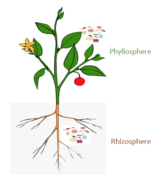| Part of a series on |
| Microbiomes |
|---|
 |
The root microbiome (also called rhizosphere microbiome) is the dynamic community of microorganisms associated with plant roots.[1] Because they are rich in a variety of carbon compounds, plant roots provide unique environments for a diverse assemblage of soil microorganisms, including bacteria, fungi, and archaea. The microbial communities inside the root and in the rhizosphere are distinct from each other,[2] and from the microbial communities of bulk soil,[3] although there is some overlap in species composition.
Different microorganisms, both beneficial and harmful, affect the development and physiology of plants. Beneficial microorganisms include bacteria that fix nitrogen, various microbes that promote plant growth, mycorrhizal fungi, mycoparasitic fungi, protozoa, and certain biocontrol microorganisms.[1] Pathogenic microorganisms can also include certain bacteria, fungi, and nematodes that can colonize the rhizosphere. Pathogens are able to compete with protective microbes and break through innate plant defense mechanisms.[1] Some pathogenic bacteria that can be carried over to humans, such as Salmonella, enterohaemorhagic Escherichia coli, Burkholderia cenocepacia, Pseudomonas aeruginosa, and Stenotrophomonas maltophilia, can also be detected in root microbiomes and other plant tissues.[1]
Root microbiota affect plant host fitness and productivity in a variety of ways. Members of the root microbiome benefit from plant sugars or other carbon rich molecules. Individual members of the root microbiome may behave differently in association with different plant hosts,[4] or may change the nature of their interaction (along the mutualist-parasite continuum) within a single host as environmental conditions or host health change.[5]
Despite the potential importance of the root microbiome for plants and ecosystems, our understanding of how root microbial communities are assembled is in its infancy.[6][7] This is in part because, until recent advances in sequencing technologies, root microbes were difficult to study due to high species diversity, the large number of cryptic species, and the fact that most species have yet to be retrieved in culture.[8] Evidence suggests both biotic (such as host identity and plant neighbor) and abiotic (such as soil structure and nutrient availability) factors affect community composition.[9][10][11][12][13]
- ^ a b c d Mendes R, Garbeva P, Raaijmakers JM (September 2013). "The rhizosphere microbiome: significance of plant beneficial, plant pathogenic, and human pathogenic microorganisms". FEMS Microbiology Reviews. 37 (5): 634–63. doi:10.1111/1574-6976.12028. PMID 23790204.
- ^ Gottel NR, Castro HF, Kerley M, et al. (September 2011). "Distinct microbial communities within the endosphere and rhizosphere of Populus deltoides roots across contrasting soil types". Applied and Environmental Microbiology. 77 (17): 5934–44. Bibcode:2011ApEnM..77.5934G. doi:10.1128/AEM.05255-11. PMC 3165402. PMID 21764952.
- ^ Nguyen C (2009), "Rhizodeposition of Organic C by Plant: Mechanisms and Controls", Sustainable Agriculture, pp. 97–123, doi:10.1007/978-90-481-2666-8_9, ISBN 978-90-481-2665-1
- ^ Kogel KH, Franken P, Hückelhoven R (August 2006). "Endophyte or parasite—what decides?". Current Opinion in Plant Biology. 9 (4): 358–63. doi:10.1016/j.pbi.2006.05.001. PMID 16713330.
- ^ Smith SE, Read DJ (2010). Mycorrhizal symbiosis (3rd ed.). New York, NY: Academic Press. ISBN 978-0-08-055934-6.[page needed]
- ^ Kristin A, Miranda H (2013). "The root microbiota—a fingerprint in the soil?". Plant and Soil. 370 (1–2): 671–86. doi:10.1007/s11104-013-1647-7. S2CID 14961515.
- ^ Nemergut DR, Schmidt SK, Fukami T, O'Neill SP, Bilinski TM, Stanish LF, Knelman JE, Darcy JL, Lynch RC, Wickey P, Ferrenberg S (September 2013). "Patterns and processes of microbial community assembly". Microbiology and Molecular Biology Reviews. 77 (3): 342–56. doi:10.1128/MMBR.00051-12. PMC 3811611. PMID 24006468.
- ^ Buée M, De Boer W, Martin F, van Overbeek L, Jurkevitch E (2009). "The rhizosphere zoo: An overview of plant-associated communities of microorganisms, including phages, bacteria, archaea, and fungi, and of some of their structuring factors". Plant and Soil. 321 (1–2): 189–212. doi:10.1007/s11104-009-9991-3. S2CID 45768977.
- ^ Dean SL, Farrer EC, Taylor DL, Porras-Alfaro A, Suding KN, Sinsabaugh RL (March 2014). "Nitrogen deposition alters plant-fungal relationships: linking belowground dynamics to aboveground vegetation change". Molecular Ecology. 23 (6): 1364–78. doi:10.1111/mec.12541. PMID 24112704. S2CID 15540300.
- ^ Dean SL, Farrer EC, Porras-Alfaro A, Suding KN, Sinsabaugh RL (2014). "Assembly of root-associated bacteria communities: interactions between abiotic and biotic factors". Environmental Microbiology Reports. 7 (1): 102–110. doi:10.1111/1758-2229.12194. PMID 25870878.
- ^ Hardoim PR, Andreote FD, Reinhold-Hurek B, Sessitsch A, van Overbeek LS, van Elsas JD (July 2011). "Rice root-associated bacteria: insights into community structures across 10 cultivars". FEMS Microbiology Ecology. 77 (1): 154–64. doi:10.1111/j.1574-6941.2011.01092.x. PMC 4339037. PMID 21426364.
- ^ Egerton-Warburton, Louise M.; Johnson, Nancy Collins; Allen, Edith B. (November 2007). "Mycorrhizal Community Dynamics following Nitrogen Fertilization: A Cross-Site Test in Five Grasslands". Ecological Monographs. 77 (4): 527–44. doi:10.1890/06-1772.1. JSTOR 27646105.
- ^ Tedersoo L, Bahram M, Toots M, Diédhiou AG, Henkel TW, Kjøller R, Morris MH, Nara K, Nouhra E, Peay KG, Põlme S, Ryberg M, Smith ME, Kõljalg U (September 2012). "Towards global patterns in the diversity and community structure of ectomycorrhizal fungi". Molecular Ecology. 21 (17): 4160–70. doi:10.1111/j.1365-294X.2012.05602.x. hdl:11336/18182. PMID 22568722.